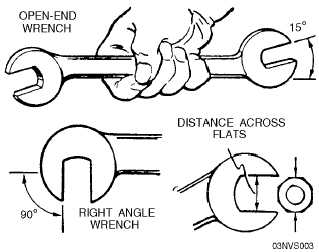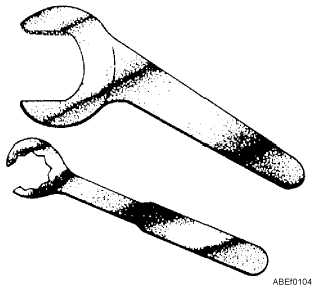The size of any wrench used on bolt heads or nuts is
determined by the size of the opening between the jaws
of the wrench. The opening of a wrench is
manufactured slightly larger than the bolt head or nut
that it is designed to fit. Hex-nuts (six-sided) and other
types of nut or bolt heads are measured across opposite
flats (fig. 1-26). A wrench that is designed to fit a
3/8-inch nut or bolt usually has a clearance of from 5 to
8 thousandths of an inch. This clearance allows the
wrench to slide on and off the nut or bolt with a
minimum of "play." If the wrench is too large, the
points of the nut or bolt head will be rounded and
destroyed.
There are many types of wrenches. Each type is
designed for a specific use. Let's discuss some of them.
OPEN-END WRENCHES
Solid, nonadjustable wrenches with openings in
one or both ends are called open-end wrenches. (See
fig. 1-26.) Usually they come in sets of from 6 to 10
wrenches, with sizes ranging from 5/16 to 1 inch.
Wrenches with small openings are usually shorter than
wrenches with large openings. This proportions the
lever advantage of the wrench to the bolt or stud and
helps prevent wrench breakage or damage to the bolt or
stud. One exception exists.
Hydraulic piping installations for catapult and
arresting gear are often in close spaces. During certain
phases of hydraulic maintenance it may be impossible
to swing an ordinary wrench because of its length.
Ordinary wrenches that are normally available increase
in length as their size increases. Thus, when a large-size
wrench is needed, the length of the wrench sometimes
prevents its use, due to the space available to swing the
wrench. The Bonney wrench, shown in figure 1-27, is
an open-end wrench that may be used to great
advantage because of its thickness and short length.
This wrench is normally procured in the larger sizes,
although it is available in a range of sizes to fit most
hydraulic fittings.
Open-end wrenches may have their jaws parallel to
the handle or at angles anywhere up to 90 degrees. The
average angle is 15 degrees (fig. 1-26). This angular
displacement variation permits selection of a wrench
suited for places where there is room to make only a
part of a complete turn of a nut or bolt. If the wrench is
turned over after the first swing, it will fit on the same
flats and turn the nut farther. After two swings on the
wrench, the nut is turned far enough so that a new set of
flats are in position for the wrench, as shown in figure
1-28.
Handles are usually straight, but may be curved.
Those with curved handles are called S-wrenches.
Other open-end wrenches may have offset handles.
This allows the head to reach nut or bolt heads that are
sunk below the surface.
1-19
Figure 1-26.—Open-end wrenches.
Figure 1-27.—Bonney wrenches.



